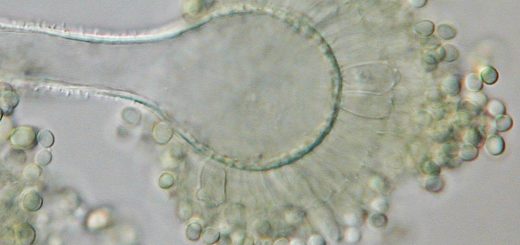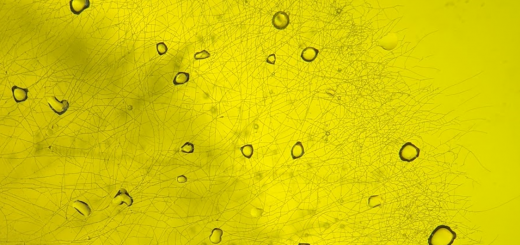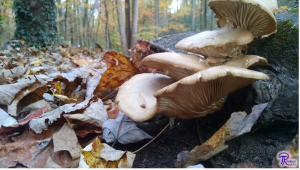#004: Fungal Hyphae Are Not Made Up of Traditional Cells
The mycelium of a fungus is made up of one continuous cytoplasm and is thus said to be coenocytic. Most hyphae have structures called septa that divide the hyphae into cells. Each septum has a central pore (or multiple micropores) which allows it to regulate movement of nuclei and other organelles and to allow nutrients and resources to be quickly moved around. There are a few levels of complexity of septa. The least complex level has no septa, and the nuclei are free to move around the hyphae. In this case there are many nuclei in each hyphae and the hyphae are said to be polykaryotic (plant and animal cells are usually monokaryotic*). In mated fungi, this allows for an interesting situation where you can think about populations of nuclei within an individual. Other hyphae are septate but have a large pore at the center of each septum. This pore allows all organelles to pass through. Thus, each cell is not restricted in the number of nuclei it can contain. Other fungi have septa perforated by multiple micropores**. These do not allow movement of organelles but do allow molecules to pass through. The most complex septa are called dolipore septa and have a parenthosome around the pore which regulates movement through the pore. In these hyphae, nuclei are limited to two per cell (why two? See FFF#009 for an answer), though mitochondria and small organelles can pass through. In order for these hyphae to grow, they must follow a complex process which results in the formation of clamp connections. Clamp connections look like semicircular bumps on the outside of the hypha, centered at the septum. Only basidiomycetes (though not all) form clamp connections. Septal pores (of any complexity) can close completely in certain situations, usually in response to damage or to allow sexual structures to differentiate. In the event of damage, Woronin bodies—small organelles located near the pore—move into the pore and seal it off. In dividing yeast cells, a septum forms and closes completely to produce two new cells. In budding yeast this process leaves a scar at the dividing point. The cell will never again be able to bud from this scar, so the number of divisions for any one cell is limited. Fungi may change the complexity of their hyphae, especially after mating. Basidiomycetes capable of forming dolipore septa often do not have these structures until they are mated and have a need to regulate their nuclei.
*Skeletal muscle cells are syncytial, where several monokaryotic cells have fused to create a large cell with multiple nuclei.
**This is analogous to plasmodesmata found in plant cells.
See Further:
http://www.fungionline.org.uk/3hyphae/3septa.html
http://bugs.bio.usyd.edu.au/learning/resources/Mycology/StructureFunction/hyphalStructure.shtml
http://www2.mcdaniel.edu/Biology/botf99/fungifromweb/basidomycetes.html (especially the first and sixth pictures)









![#011: Characteristics of Kingdom Fungi [Archived]](https://www.fungusfactfriday.com/wp-content/themes/hueman/assets/front/img/thumb-small-empty.png)


3 Responses
[…] animal cells are multicellular. For example, organelles often move between hyphal cells. Check FFF#004 for more on this […]
[…] for the majority of its life, the mycelium contains two nuclei per cell (one from each parent, see FFF#004 and #009). Some basidiomycetes form clamp connections to regulate the number of nuclei in each […]
[…] Next story #004: Fungal Hyphae Are Not Made Up of Traditional Cells […]